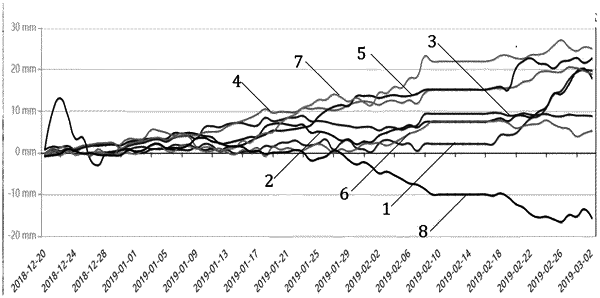| CPC G01S 13/9023 (2013.01) [G06T 7/60 (2013.01); G06T 2207/10028 (2013.01); G06T 2207/30181 (2013.01)] | 4 Claims |

|
1. A method for precise location of a slope collapse area, wherein the method comprises the following steps:
obtaining slope images in a time series by using a ground-based synthetic aperture radar;
composing the slope images in the time series into two-dimensional slope deformation graphs by using a false color composition;
selecting a respective area of each of the two-dimensional slope deformation graphs with a maximum deformation in the respective two-dimensional slope deformation graph as a respective deformed area;
conducting line partitioning on each respective deformed area in a respective slope image at a first time point in the slope images in the time series to obtain respective straight lines, and setting multiple reference points on each of the respective straight lines;
conducting line partitioning on the respective deformed areas in the slope images in the time series after the first time point through line connection based on the multiple reference points of each respective straight line, to obtain a corresponding connecting line of each respective straight line in a respective one of the slope images in each time point that is after the first time point;
displaying the deformed areas, obtained after line connection, in the slope images in the time series in an overlapping manner, to obtain an overlapped image of the deformed areas;
selecting an area that is in the overlapped image and that is corresponding to a connecting line with a largest variation range as a monitoring line area;
dividing the monitoring line area in the slope image at the first time point in the slope images in the time series at an equal spacing to obtain multiple monitoring points; and
determining a location of a collapsed area of a slope according to a coordinate change of each monitoring point in the slope images in the time series.
|